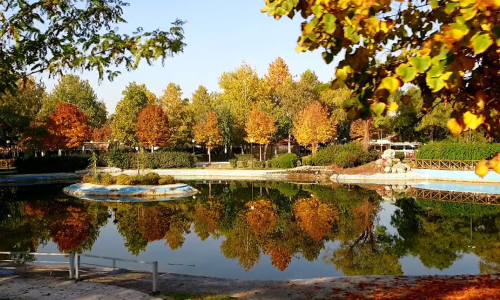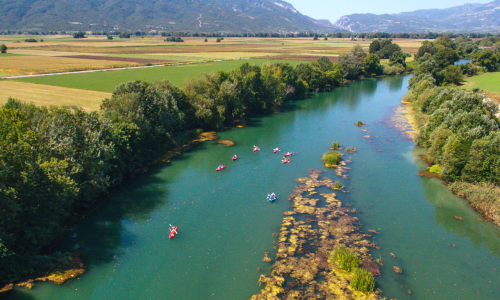Olympus Terra Hotel is located on the northwest side of Larissa where the route to the mythical Olympus Mountain begins. It is just a few minutes from the city center and next to two remarkable green sites, the Alsos and the park “Alkazar”, which are crossed to the legendary river of Thessaly, Pinios.
OLYMPUS TERRA HOTEL
Explore Thessaly
Discover the city of Larissa
Larissa is a colorful area of cultivated lands and scents of fertile and rich grounds. The city of Larissa, a small paradise in the heart of the Thessalian plain, offers a journey of authentic experiences, gastronomic pleasures, tradition and rich history from ancient to modern times. Upon arriving at the city center you will see historical sights, busy alleys, imaginative restaurants and traditional taverns of another era. You will experience intense moments in a lively and colorful city. In Larissa city, many historically important hidden monuments are waiting for you to discover.
The tomb of the most famous doctor of the ancient times and father of Medicine, Hippocrates, is located in Larisa. In an overflow of Pinios in the 19th century, the power of nature revealed this historical place and a statue was placed in his honor. Inside the museum busts of other well-known important doctors of modern times have been collected and exhibited as well as a marble plaque with the oath of Hippocrates in the museum. At the exhibition you can also see his writings and photographs of the medical tools he used.
The Acropolis of the city is located on the hill of Agios Achilleios. Based on archeological research, the area has been inhabited since the Neolithic era. What has also been discovered is that during the Classical era the Acropolis of Larissa was located at the same place. At the same place where the early Christian Basilica of St. Achilles is also located. Excavations have uncovered the remains of a large Basilica with fragments of a stone plaque revealing its founder, Archbishop Achilles.
Bezesteni was built by the Ottomans on the “Fortress Hill” of the ancient Acropolis in a wide-open space. For the Ottomans, this name corresponds to a large, vital, roofed market that operated for 3 centuries, supplying the inhabitants with essential goods.
Two ancient theaters are located on the south side of the Acropolis, the First Theater could accommodate over 10,000 spectators. When the Romans took over of the area, they turned it into an arena, while the theatrical events of the city were taking place at the NW Ancient Theater. The Second Ancient Theater was used for worship festivals, musical and theatrical performances, sports games and political gatherings.
It is the second highest mountain in the Balkans with an altitude of nearly 3,000 meters and is located at the borders of Macedonia and Thessaly, with the highest peak being Mytikas. It has been declared a National Park since 1938 and thousands of people visit the mountain every year to enjoy and explore its high peaks and deep gorges. The most impressive sight is the central vertical gorges which form a sharp angle and impress the observer’s eye.
The water of the river Pinios, the largest river in Thessaly and the most important natural element in Greece flows in the Aegean Sea. It is 200 km long and has crossed the city center of Larissa since ancient times. According to ancient Greek mythology Pinios was the son of the god Ocean and the river got his name because he lived in Thessaly.
Tempi or the Valley of Tempi was a passage that served strategic decisions during the wars and connects Macedonia with Thessaly. The valley is famous for its natural beauty, its dense forests and rich biodiversity. The Pinios River flows through the valley and is a refuge for migratory birds. Ancient books refer to a great earthquake which separated the two mountains pushing the lake of the water to uncover the Thessalian plain.
Pelion is known as the mountain of Centaurs because it was their homeland, while it also was the summer residence of the 12 Olympus gods. For some people, Pelion has been misunderstood as being only an autumn and winter destination. But the truth is that its beaches remind us of exotic places and islands rich in plantation.
The combination of mountain and sea especially in summer is the ideal holiday setting since the mountain has cool temperatures while when visiting the sea, you can feel the summer heat.
Lake Plastira is surrounded by 18 beautiful villages in a like a fairytale landscape, rich in plantation. The artificial lake which is called “the 4 seasons” by the locals, changes colors and images depending on the season. Walking 55 km around the lake you will find picturesque villages, traditional taverns with local food and many opportunities for sports activities such as hiking, horseback riding, archery and rowing.
Beauty cannot be hidden when it involves nature. The rocky trails and monasteries overlooking the gigantic mountains are some of the impressive sites you will see while visiting. This amazing place has been inscribed on the list of UNESCO World Heritage Site since 1988. Monasteries have been built since the 11th century on rocks formed about 60 million years ago. An excellent destination for hiking and religious tourism.
The Schwatz Mansion of 1778 is one of the most important buildings in Greece. The president of the settlement of Ambelakia, George Mavros Schwartz, used it as his main residence while its construction and elaborate architecture reflected the socioeconomic power that the region had at that time. Today, the mansion is a sample of unique architectural construction and the special aesthetics of the 18th century.


